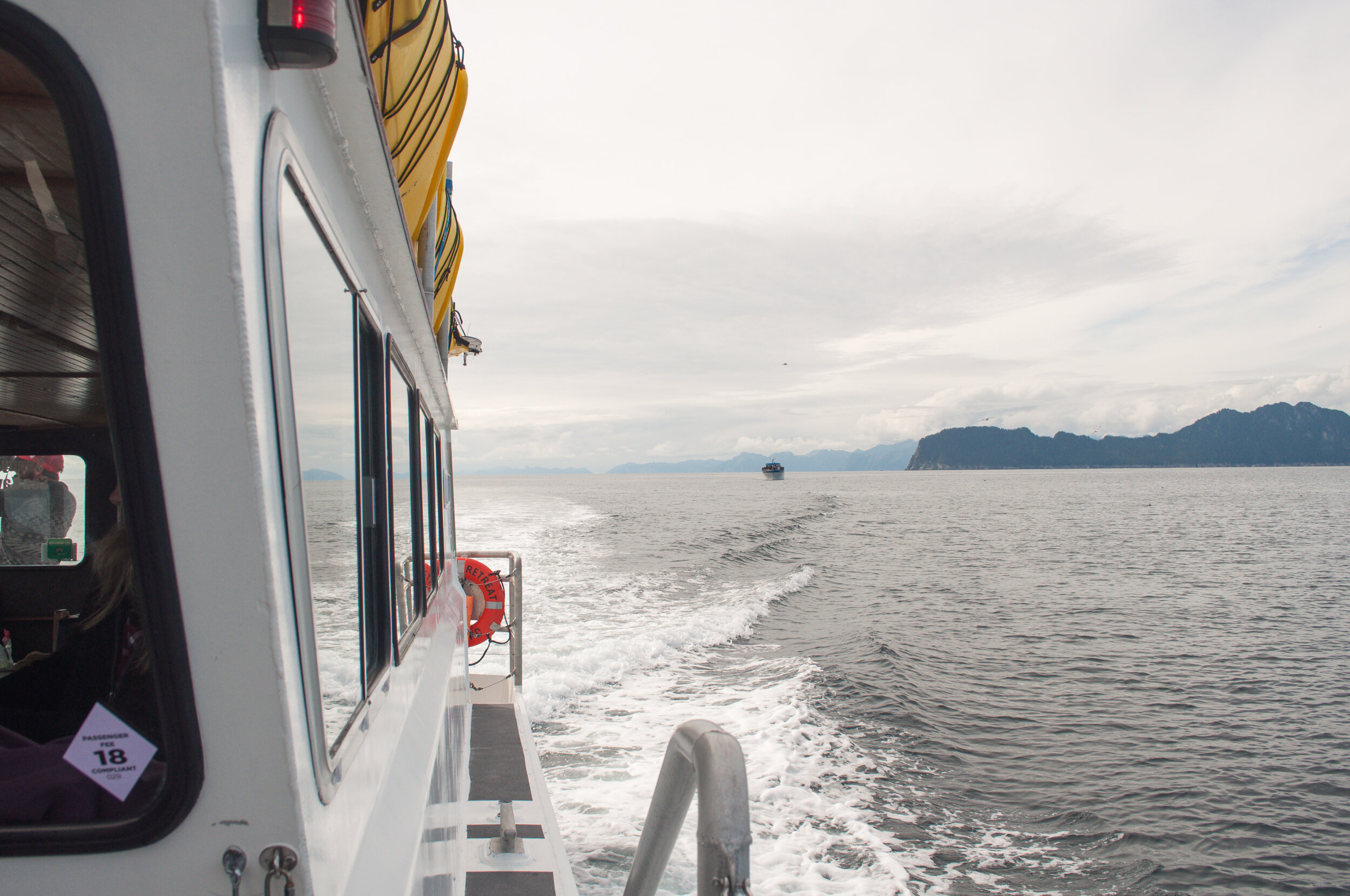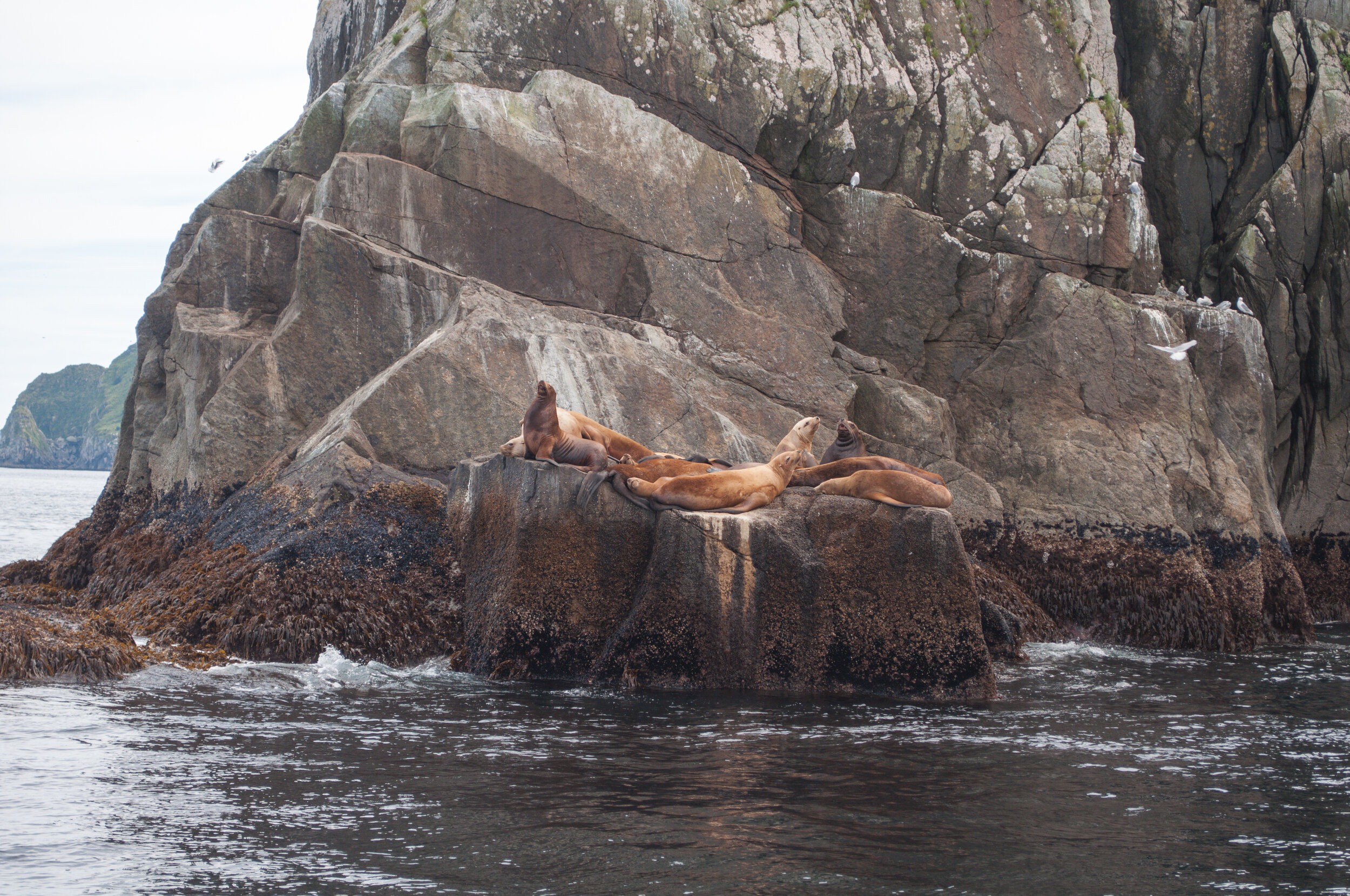A Perfect 2 Days in Kenai Fjords National Park
As it turns out, Alaska national parks are intimidating AF. Or is it just me?? The weather, the scenery, the seasons...these factors loom in the distance like a bear that’s happy eating its berries until he thinks those hikers he sees might pose a threat to his feasting, ready to strike at any moment! The bear is probably scared of humans, you say? Think again! This is Alaska we’re talking about! Wow, that metaphor really got out of hand.
Planning a visit to these parks can be hard (also I can’t be the only person out there who’s scared of bears). I’m starting here with the park that, in my opinion, is the easiest to visit: Kenai Fjords! Arguably THE BEST national park for wildlife viewing, specifically marine wildlife, I’m going to share all the lovely details of my visit!
Getting to the Park
Kenai Fjords National Park is situated on the Kenai Peninsula, a two and a half hour drive south on Anchorage.The drive is absolutely gorgeous in and of itself--the road hugs Turnagain Arm (known for beluga whale sightings) as it winds south, complete with views of mountains and glaciers. When you arrive in Seward, you’ll have two options for entry into the park: you can drive into the park at Exit Glacier, or you can float into the park in Resurrection Bay. I chose to do both and spent two days at Kenai Fjords, which is enough time to get a perfect overview of what this icy wonderland has to offer.
DAY ONE
Exit Glacier
I drove straight from Anchorage to the Exit Glacier area, arriving around 11am. This is the only area of the park accessible by car and home to the only established hiking trails in the park. Exit Glacier itself can be seen in the distance as you drive past signs along the road demonstrating the reach of the glacier in years past. While it has receded quite drastically, the grandeur of blue ice is still alive and well!
Behind the nature center, the trail system begins with a one-mile paved loop, which includes an overlook and view of the glacier. From this trailhead, I had the option to take an easy two mile trail toward Exit Glacier, or trek up a mountain to the Harding Icefield.
The Harding Icefield Trail
To me, hiking the Harding Icefield trail while visiting Kenai Fjords was a no-brainer. This 8.2 mile trail is still the hardest hike I’ve ever done, even as I write this a year later. According to the official national park site, the out-and-back trail gains 1,000 feet of elevation for every mile, and I for real almost didn’t make it. Luckily, I met a kind stranger when I was halfway up and losing steam, and he paced with me for the remainder of the climb.
The Harding Icefield Trail is naturally divided into a few distinct sections--hard, harder, hardest, and Harding! Okay, lame joke. Tree cover surrounds the beginning of the route, with a few breaks in the trees where you can see the outwash plain at the base of Exit Glacier. At 1.4 miles the trees open up to Marmot Meadows. It took me a little over an hour to reach this point--a perfect stop for lunch! Marmot Meadows is the type of place that makes you want to frolic around and sing “The Hills are Alive”...but you shouldn’t! The trail was marked with “revegetation area” signs along the way, to hopefully deter those of us who are filled with the sound of music from trampling on the fragile flora. Marmot Meadows also has a lovely view of Exit Glacier, making it a popular turnaround point for anyone who doesn’t want to hike the whole trail. I stopped for lunch (and to catch my breath) and then continued onward.
From Marmot Meadows, the trail switchbacks up the mountainside, now above the treeline.I became slower and slower as the terrain became rockier and steeper, constantly checking the view behind me to see just how high I was climbing. Eventually the lush, green alpine meadows turned into a rocky gray expanse dotted with patches of snow. Earlier in the summer this section can be totally covered in snow, but during my mid-August visit I only had to cross over snow a small handful of times.
An emergency shelter signals that you’re approaching your destination--something I was very excited and relieved to see! By that point I’d completed the steepest of the ascentI was more than ready to lay eyes on A LOT of ice. At long last, Harding Icefield came into view! Is there a nature version of culture shock? This seems like the best way to describe how I felt at that moment. I was the farthest from home I have ever been, sitting in this alien world of rock and ice and snow.
The Harding Icefield Itself
Kenai Fjords National Park was designated for the purpose of protecting the icefield, which of course motivated my interest in seeing the ice with my own two eyes. The icefield covers 700+ square miles, not including the multitude of glaciers that flow from it.The sheer magnitude of ice in front of me was illustrated by the pointy tops of mountains just barely poking out from their blanket of white. It is truly a sight to behold, and one I won’t easily forget.
It was the first day of my Alaska adventure and I was in a place like no other, having accomplished something I wasn’t sure I could do. What a day!
The return hike took about half the amount of time as the ascent, for a total hiking time of about 7 hours. After our descent, my new hiking friend and I got dinner at Seward Brewing Company, and then it was time to find a campsite.
Camping in Seward
Kenai Fjords has one campground within the park. While I normally choose to camp inside a national park if I have the option, this time I didn’t. The park campground is in the Exit Glacier section, and the city of Seward has a large system of campgrounds in town, right on the bay. Since I had an early morning on the water the following day, I opted to stay in town. The campgrounds are all right next to each other, and I had no issue finding a site that evening.
DAY TWO
Choosing the Right Cruise Experience
Before we dive into my experience, let’s talk about options for seeing the park from the water. The easiest and most common way to see Kenai Fjords is by taking a wildlife viewing day cruise. If you only do one thing in the park, this should be it. Taking a wildlife cruise is the equivalent of driving along the scenic road in any other national park--it’s the quickest way to see as much of the park as possible, and the views pack a big punch.
Your other option is to sea kayak. Unless you are a strong kayaker or content to stay near the harbor, you’ll have to take a boat ride to get into the backcountry.
I wanted to do both! Since I’m not a very experienced kayaker and am terrible at planning float trips (which we learned in Congaree National Park), I knew that I would need to go on a guided excursion for my own safety. I looked at taking a kayaking tour of Resurrection Bay, and also booking a separate wildlife cruise. I really wanted to get deeper into the park than booking both activities separately allowed for, though, and it also wasn’t more cost effective to book this way. This led me to ultimately choose to take a combo sea kayak and wildlife cruise tour with Sunny Cove Sea Kayaking.
THIS WAS THE MOST EXPENSIVE THING I DID ON THE WHOLE TRIP, OR ANY OTHER NATIONAL PARK TRIP I HAVE TAKEN. Normally, my trip recaps reflect a pretty budget-friendly approach to national parks. That is not the case here. I really wanted to see as much of the park as I could, but I also wanted the more intimate experience of seeing it at water level from a sea kayak. The Sunny Cove Grand Day Tour was the best of both worlds, so I booked it.
Spoiler alert: it was money well spent.
Sea Kayaking in Holgate Arm
I was up at the crack of dawn for a 7am departure from the Sunny Cove office on 4th Street. In total there were 13 people aboard for the day--9 tourists (myself included), 2 kayak guides, the captain and the deckhand/first mate(?). The small group number was yet another reason I chose the combo tour. As we made our way to our kayaking destination through the glare of the morning sun, our guides circled from table to table to introduce themselves. They answered any and all questions, and distributed wildlife bingo cards. The morning boat ride was longer than I expected, for the purpose of depositing us deep within the park before the arrival of the other cruises.
Once inside Holgate Arm, I changed into my rubber boots (complements of Sunny Cove) and disembarked onto a pebble beach. After a quick lesson, we launched our six kayaks into the water.
The weather was absolutely perfect. Clear skies with no wind made for calm water and easy paddling. Little icebergs drifted past as we moved in the direction of the star of the show--Holgate Glacier.
The first time I heard it, I thought it was thunder. The sound of the glacier calving was startling, and I actually checked the sky for incoming storm clouds before realizing what it was. The mass of blue and white ice looked stoic and regal against the water and mountains. We floated along a safe distance away, from the beach at the northern side of the arm to the south. The pace was leisurely, giving me plenty of time to soak in my surroundings. I spied a sea otter and a jellyfish, but mainly just had eyes for that glacier.
We beached on a pebble shoreline on the southside of the arm for a picnic lunch in view of our new icy friend. Lunch, provided by Sunny Cove, consisted of a sandwich with way more snacks than needed (many of which I saved for later) and warm soup served from a hydroflask! While our small group enjoyed lunch, our vessel (which had exited the arm) returned to sweep us along on our way.
Wildlife Cruise
Back on the boat, we had one main goal: whales. We came upon two humpback whales almost immediately into the afternoon voyage. Whales! And so began our five hour wildlife cruise.
Having gotten to know each other over the course of the morning, there was a sense of camaraderie as we immersed ourselves even more in the grandeur of nature. We talked and laughed and shared the best positions onboard to see animals.
For the rest of the day, we hopped from island to rock to island in pursuit of wildlife, and let me tell you, it was NOT hard to find! From the cutest puffins to the most massive sea lions and everything in between, I don’t expect to ever see so many animals in one national park ever again. We all stood on the deck of the boat for hours taking it all in, our bingo cards laying forgotten in the cabin. Seriously you guys, this is your park for marine wildlife.
As the day began to wind down, I sat on the bow in conversation with one of the guides. The scenery around me was unreal; my first two days in Alaska had been a whirlwind. At the end of a long, fulfilling day, I departed the Seward harbor for Anchorage, onto my next Alaska adventure.































